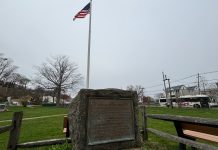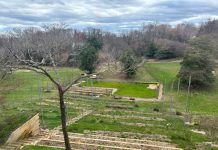By Andrew Spears
One of nature’s most spectacular gifts is that it offers us signs no matter where we are, beautiful affirmation that its virility pulses in an unstoppable rhythm through our world. Signs that show that we are not merely living side by side with nature but that we are living within it, even here in our suburban landscape. In spite of our efforts to hold nature at bay, it nudges back and invites us to linger. All we need to do is pause for a moment, watch and listen.
Birds are the most accessible of nature’s signs because they can be encountered in the most common places. Birds are constantly on the move and forces of migration, breeding, weather, and food supply often set them down right at our front doors. Uncommon and common birds can be enjoyed throughout our daily routines in familiar and ordinary places: a shopping center parking lot, our child’s soccer field, or a roadside telephone wire. Each encounter with a bird offers a portal into nature’s wonders.
Fall migration will continue through November as birds make their way to more temperate climates for the winter. During this cyclical southern surge of birds, birders have learned to watch for uncommon birds just about anywhere. While parks and preserved open spaces attract good numbers of birds, you don’t need to travel to a wildlife refuge to enjoy them.

If you see movement in the medians at your local shopping center, take a second look. It may not be the ubiquitous parking lot panhandler, the House Sparrow, but rather a songbird on its southerly journey. I recently found a Chestnut Sided Warbler scampering down the sidewalk in front of the Pottery Barn…a beautiful and unexpected site. I’ve seen Ruby Crowned Kinglets snatching gnats from the Hydrangea leaves on a Red Bank side street and a Lincoln’s Sparrow foraging among an arborvitae hedge at Walgreen’s.
My commute to work leads me down Swimming River Road from Tinton Falls into Lincroft, passing the reservoir’s spillway at the water company’s plant. This spillway is attractive to birds, providing ready access to fish and other food sources. Passing motorists who have learned where to look, enjoy striking views of one of the resident Bald Eagles perched on a snag above the falling water. Great blue herons often stake out a sunny spot at the spillway’s base, waiting in stealthy silence for an unsuspecting minnow or frog. And Double Crested Cormorants line the rim of the concrete dam for their annual December convention, swelling to numbers in excess of 100.
Ball fields, especially after a fall rain, attract a diverse gathering of birds picking worms and insects that rise to the surface from the saturated sod. At first glance, it may appear as a collection of Laughing Gulls. But a closer inspection often reveals three or four species of gulls, Killdeer, and perhaps a Black Bellied Plover or two. In addition to athletic fields, sod farms, due to the regular disturbance of the soil and exposed food supply, are known to attract migrating plovers and sandpipers.

Roadside trees, wires, and bridges provide great roosts for hawks and passerines. A flash of white on a bare branch along Route 18 reveals a Red Tailed Hawk scanning for small mammals. Tree Swallows gather on wires by the hundreds, staging before their passage south. And that dark silhouette perched on the rail of the Oceanic Bridge just might be a Peregrine Falcon, North America’s fastest bird.














